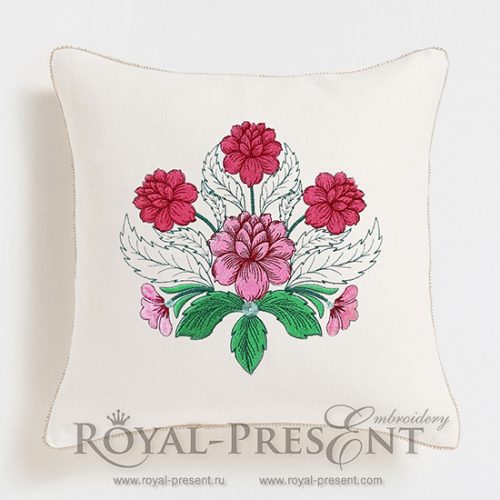Royal Present Embroidery presents one of the most recognizable patterns, which has turned into a spectacular machine embroidery design. You have certainly heard such names as “buta”, “Paisley”, “tear of Allah”, “Persian cypress”, “Indian”, “Eastern”, or Turkish Cucumber. You know, they all refer to the same ornament, reminiscent of a drop, leaf or a nut.
The original almond-shaped motif has different names in different cultures. As a rule, it is not taken out of nowhere, and is connected with national traditions. India has long been considered the homeland of “cucumbers”, because that’s from where the image went around the world. Today, researchers are quite sure that Turkish Cucumber first appeared in Persia in the III century.
Showing the whole through its part is one of the characteristic features of Persian art. The sacred cypress tree was often depicted as a single elongated leaf. The ornament was very popular and could not avoid migrating to neighboring countries. The Indians were especially fond of it. To this day various peoples of the East call it “buta”, with the accent on the last syllable. In Sanskrit it means “fire”.
Free machine embroidery design Turkish Cucumber
Size: 62.7×103.7 mm (2.47×4.08 “), Stitches: 6501
Formats: pes, .pec, .hus, .vip, .dst, .exp, .sew, .dat, .vp3, .jef
Buta came to the West on the wave of the enthusiasm for bright cashmere fabrics. The Europeans imported them from the Indian colonies, along with spices, wooden and ivory handicrafts, precious stones and other goods. In our time the term “buta” has survived in Europe only in the French language, turning into a “boteh”. These teardrop-shaped squiggles are better known as “paisley”. It would seem that the word is not Eastern, so where did it come from?
Paisley is a town in Scotland, which gained popularity thanks to the fancy pattern. A textile center opened there in the 19th century and began to produce fabrics with the trendy ornament. Scottish textiles were much cheaper than Indian. Due to this, the image captured all of Europe and gradually entered the ranks of the classics. Nowadays, “paisley” is a universal designation for the droplet-shaped motif.
Still, there are also other names. People compare the image with mango, palm leaf and even cucumber. The latter option is typical for Russia. For the Russian person, Turkish Cucumber is a pattern from the grandmother’s trunk, which regularly comes back into fashion. Now the Royal Present Embroidery collection has it too. You can download Free machine embroidery design Turkish Cucumber for free and use it to decorate the most diverse textiles.
You may also like
Free Machine Embroidery Design Peonies

Author: Ludmila Konovalova
My name is Ludmila Konovalova, and I lead Royal Present Embroidery. Embroidery for me is more than a profession; it is a legacy of my Ukrainian and Bulgarian heritage, where every woman in my family was a virtuoso in cross-stitch and smooth stitching. This art, passed down through generations, is part of my soul and a symbol of national pride.
Date: 19.02.2015




 Get Sign-In Link
Get Sign-In Link Login with Google
Login with Google Login with Facebook
Login with Facebook Login with Amazon
Login with Amazon Login with Paypal
Login with Paypal